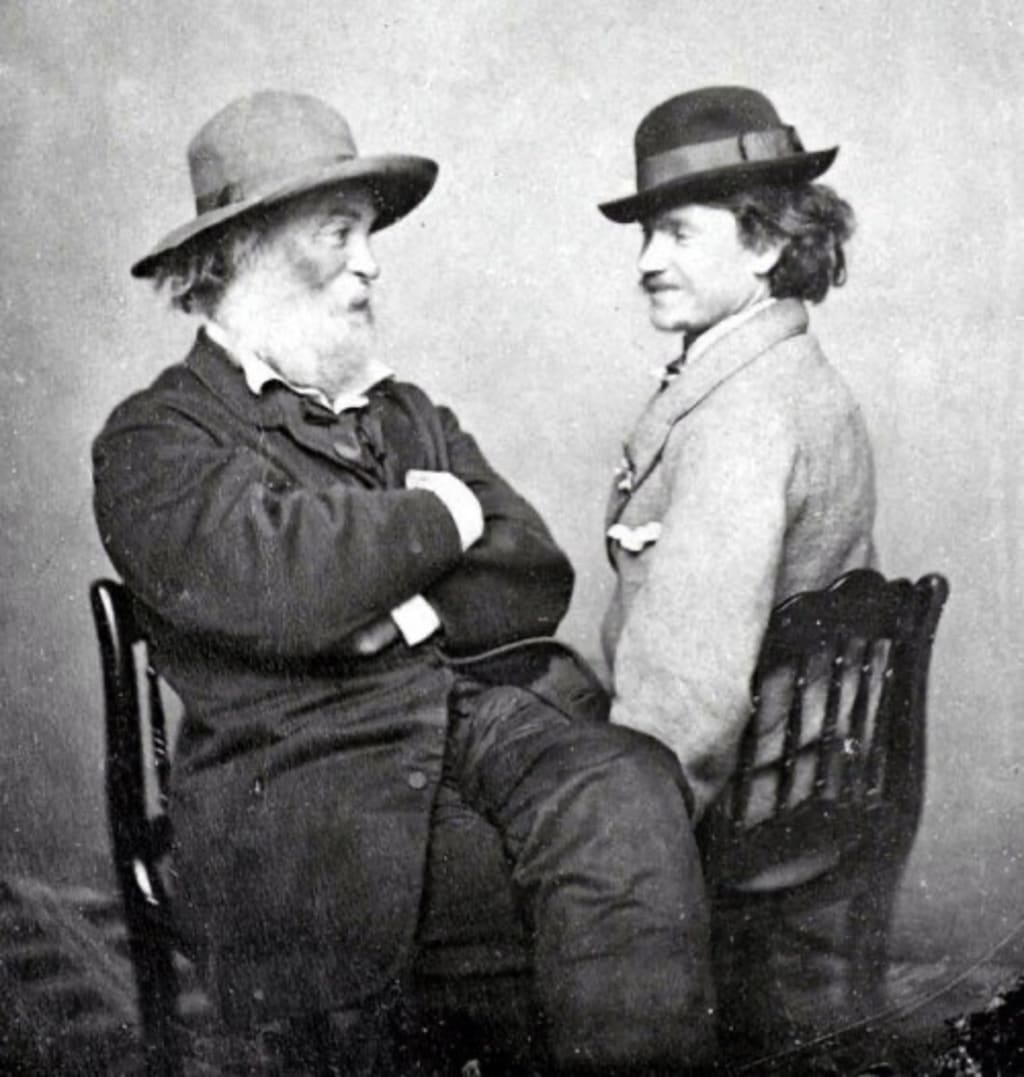Walt Whitman and Peter Doyle
A Transformative Bond that Shaped American Literature

Walt Whitman, a luminary in American literature, has etched his legacy through the groundbreaking poetry collection "Leaves of Grass." Beyond his literary prowess, Whitman was a fervent individualist, particularly evident in his unconventional relationships, notably with men.
In the pivotal year of 1865, Walt Whitman, then 45 years old, stood at the zenith of his life. The accomplished American poet had already left an indelible mark on the literary landscape, with multiple editions of "Leaves of Grass" and other notable works under his belt.
However, it was in this transformative year that Whitman's life took an unexpected turn. Early in 1865, he crossed paths with Peter Doyle, a 21-year-old who would become his steadfast friend, lover, and the inspiration behind the poignant "Calamus" poems. Their meeting took place in Washington D.C., and it marked the beginning of a profound connection that defied societal norms.
The dissimilarities between Whitman and Doyle were not confined to their age difference. Walt Whitman, a literary maestro and staunch Unionist, found an unexpected companion in Peter Doyle, who was virtually illiterate, a Confederate veteran, and earned his livelihood as a streetcar conductor. Against all odds, this unlikely pair forged a deep connection that endured for nearly three decades, transcending the social and cultural barriers of their time.
Whitman's relationship with Doyle was multi-faceted, encompassing friendship, romance, and artistic inspiration. Despite their differing backgrounds, the bond between the two men flourished, providing Whitman with a source of emotional support and creative inspiration. The intriguing dynamics of their connection offer a glimpse into a unique and unconventional companionship that withstood the test of time.
Central to their relationship was the "Calamus" series of poems, inspired by and dedicated to Peter Doyle. These verses delve into themes of love, camaraderie, and the complexities of human connection. Doyle, in his role as muse, played a pivotal role in shaping Whitman's poetic expression, adding layers of depth and emotion to the verses that would resonate for generations to come.
The 19th century was marked by stringent societal norms, particularly concerning relationships that deviated from the conventional. Whitman and Doyle, cognizant of the challenges they faced, navigated a complex terrain that required discretion and resilience. Their ability to maintain their connection despite societal pressures speaks volumes about the strength of their bond.
The dichotomy between Whitman's literary eminence and Doyle's humble occupation as a streetcar conductor adds another layer of intrigue to their story. Whitman, with his literary achievements, stood as a towering figure in American literature, while Doyle's contribution to their relationship was rooted in his unwavering loyalty and everyday experiences. This stark contrast further underscores the uniqueness of their connection.
The backdrop of the American Civil War and its aftermath adds a compelling dimension to Whitman and Doyle's relationship. Whitman, an ardent Unionist, and Doyle, a Confederate veteran, found common ground beyond the scars of war. Their ability to transcend political differences and forge a connection based on shared humanity exemplifies the power of genuine companionship.
The relationship between Whitman and Doyle endured until Walt Whitman's death in 1892. Even after Whitman's passing, the impact of their connection reverberated through the annals of American literature. The enduring legacy of the "Calamus" poems and the story of their unconventional bond continue to captivate scholars, readers, and enthusiasts, offering a nuanced perspective on love, friendship, and the limitless possibilities of human connections.
Walt Whitman and Peter Doyle's relationship, born in the crucible of the 19th century, stands as a testament to the resilience of love and friendship in the face of societal constraints. Beyond the pages of "Leaves of Grass," their story resonates as a poignant reminder of the power of human connection to transcend differences and endure through time, shaping the landscape of American literature and challenging the norms of their era.
About the Creator
Enjoyed the story? Support the Creator.
Subscribe for free to receive all their stories in your feed. You could also pledge your support or give them a one-off tip, letting them know you appreciate their work.






Comments
There are no comments for this story
Be the first to respond and start the conversation.